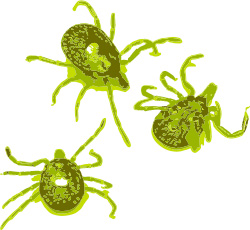Understanding Tickborne Disease

Tickborne diseases are becoming a more frequent health problem as people build homes or travel in formerly uninhabited wilderness areas where ticks and their animal hosts live. Ticks can be infected with bacteria, viruses, or parasites and can transfer potentially dangerous diseases through their bites.
There are many tickborne illnesses, and they often have similar clinical presentations, including fever, headache, fatigue, and, in rare cases, paralysis (tick paralysis). The accurate diagnosis of tickborne diseases is important because it informs treatment decisions. Laboratory testing may aid in diagnosis and thus help minimize risk of severe illness when tickborne disease is suspected. Laboratory testing strategies for tickborne diseases generally include serology and nucleic acid amplification testing (NAAT). The appropriate laboratory test depends on the suspected infection and duration of symptoms.
Detailed information about the appropriate laboratory testing strategies for different tickborne diseases can be found in the ARUP Consult Tickborne Diseases topic. Additionally, the Lyme Disease Testing Algorithm details the recommended testing strategy for suspected Lyme disease.
Tickborne Diseases in the United States
- Lyme disease
- Rocky Mountain spotted fever
- Tickborne relapsing fever
- Babesiosis
- Anaplasmosis
- Ehrlichiosis
- Tularemia
- Other: Southern tick-associated rash illness (STARI), deer tick virus (Powassan), heartland virus, and Bourbon virus
Tick Season
Tick season runs from April to September; peak months are May through August.
Disease Transmittal
Tick species vary by geographic area. Only the bites of certain tick species can transmit disease to humans.
Tickborne Testing Information
For additional information regarding antigen and antibody testing strategies, refer to the ARUP Consult Tickborne Diseases topic or the video lecture by ARUP Medical Director Dr. Marc Couturier.
FAQs
Clinical suspicion for tickborne disease is based on patient characteristics, such as the following:
- Known tick exposure, outdoor activities, or exposure to wildlife
- Illness during tick season, with symptoms such as fever, chills, headache, muscle aches, joint pain, neck pain, skin rash, Bell palsy, heart rhythm disturbances, hypotension, jaundice, or sepsis
What is the most common tickborne disease?
- Lyme disease is the most common tickborne illness in the world.
How do you know if you have been bitten by a tick?
- Thoroughly check your skin. Ticks can be tiny, so look carefully.
- Look for a rash. The "bulls eye" rash is sometimes seen in people with Lyme disease.
- However, remember that not everyone develops a rash.
How long does a tick need to be attached to a person to spread infection?
- Depending on the type of tick and germ, a tick needs to be attached to you for different amounts of time (minutes to days) to infect you with that germ.
- Watch for symptoms for 30 days, and contact your healthcare provider if you develop any of the following symptoms within 30 days after a tick bite:
- Rash
- Fever
- Fatigue
- Headache
- Muscle pain
- Joint swelling and pain
Additional Resources
ARUP Consult
CDC
Articles
- 9 Tick-Borne Diseases That Can Make You Seriously Sick—and How to Spot Them
- Tick-borne disease babesiosis now considered endemic in northern New England.
Continuing Education
- Video lecture: What’s New in Tick-borne Diseases? by Dr. Marc Couturier
















